
|
It brightened up to 3.7 mag and became a naked eye comet in mid January (Jan. 13, Marek Biely). Now it is fading. But it is bright as 6.8 mag still now (Apr. 9, Maik Meyer). In the Northern Hemisphere, it keeps observable all night until July when the comet will fade down to 13 mag. It is not observable in the Southern Hemisphere.
Date(TT) R.A. (2000) Decl. Delta r Elong. m1 Best Time(A, h)
Apr. 11 1 24.82 69 13.8 1.893 1.662 61 7.5 19:56 (160, 24)
Apr. 18 1 26.20 71 49.8 1.965 1.725 61 7.9 3:56 (198, 25)
|
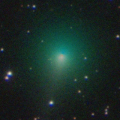
|
Now it is very bright as 8.8 mag (Apr. 3, Marco Goiato). In the Southern Hemisphere, it keeps observable in good condition for a long time until the comet fades out. In the Northern Hemisphere, it keeps extremely low and hard to observe until June. It will be observable in good condition after June while the comet will be fading gradually.
Date(TT) R.A. (2000) Decl. Delta r Elong. m1 Best Time(A, h)
Apr. 11 22 15.09 -13 57.6 1.766 1.360 49 8.7 4:06 (291, 5)
Apr. 18 22 37.92 -11 58.5 1.753 1.365 50 8.7 3:56 (288, 5)
|

|
New bright comet. Now it is 9.4 mag (Apr. 10, Alexandre Amorim). It is expected to brighten up to 6 mag in May. In the Southern Hemisphere, it keeps observable in good condition until late June. In the Northern Hemisphere, it will be unobservable soon. Then it keeps unobservable until September when the comet will be fainter than 13 mag. It must have been observable at 16 mag in good condition in 2014 autumn, but it was not discovered.
Date(TT) R.A. (2000) Decl. Delta r Elong. m1 Best Time(A, h)
Apr. 11 22 4.38 -16 45.6 1.374 1.120 53 9.7 4:06 (295, 5)
Apr. 18 22 22.92 -19 28.4 1.133 1.034 57 8.9 3:56 (296, 3)
|

|
New bright comet. Now it is 10.2 mag (Apr. 7, T. Namkhai, S. Schmalz). In the Northern Hemisphere, it will be getting higher rapidly in the evening sky. But it will fade out rapidly. It will be fainter than 18 mag in early June. It is not observable in the Southern Hemisphere.
Date(TT) R.A. (2000) Decl. Delta r Elong. m1 Best Time(A, h)
Apr. 11 0 20.91 29 55.9 0.622 0.515 25 10.6 4:06 (238, 6)
Apr. 18 2 29.49 48 47.8 0.624 0.656 39 11.6 20:03 (140, 16)
|
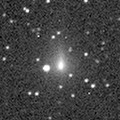
|
Bright new comet. Now it is so bright as 9.9 mag (Apr. 11, Neil Norman). It seems to be a fragment of Comets C/1988 A1 (Liller) and C/1996 Q1 (Tabur). It must have been visible bright in the evening sky from December to February in the Northern Hemisphere, but it was not discovered. It will be fading after this. But it is observable in excellent condition in the Northern Hemisphere. In the Southern Hemisphere, it is not observable until June.
Date(TT) R.A. (2000) Decl. Delta r Elong. m1 Best Time(A, h)
Apr. 11 0 3.44 63 36.2 1.136 1.028 57 10.9 4:06 (209, 26)
Apr. 18 0 20.07 73 1.0 1.088 1.105 63 11.1 3:56 (200, 30)
|
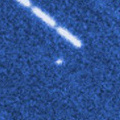
|
Now it is 12.8 mag (Mar. 21, Michael Mattiazzo). It will brighten up to 10.5 mag in May and June, but it is not observable. In the Northern Hemisphere, it will be observable after autumn while the comet will be fading.
Date(TT) R.A. (2000) Decl. Delta r Elong. m1 Best Time(A, h)
Apr. 11 2 7.87 0 4.6 2.402 1.459 15 11.5 19:56 (100,-13)
Apr. 18 2 26.79 3 9.4 2.388 1.430 13 11.3 20:03 (105,-14)
|
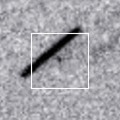
|
It will brighten up to 11 mag in April and May. But the condition is bad in this apparition. In the Southern Hemisphere, it will become observable in the morning extremely low sky after late April. It will not be observable until late July in the Northern Hemisphere.
Date(TT) R.A. (2000) Decl. Delta r Elong. m1 Best Time(A, h)
Apr. 11 0 9.21 -5 5.5 2.322 1.435 21 11.6 4:06 (267,-13)
Apr. 18 0 30.80 -3 47.7 2.334 1.461 22 11.5 3:56 (265,-13)
|
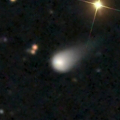
|
It brightened up to 13.6 mag until the end of 2014, brighter than originally expected (Dec. 19, Chris Wyatt). It is expected to brighten up to 4 mag from autumn to winter. In the Southern Hemisphere, it is getting higher gradually in the morning sky. In the Northern Hemisphere, it is hardly observable until 2015 December.
Date(TT) R.A. (2000) Decl. Delta r Elong. m1 Best Time(A, h)
Apr. 11 23 19.77 -21 38.6 4.052 3.363 41 11.8 4:06 (288,-12)
Apr. 18 23 24.58 -21 45.2 3.889 3.282 46 11.6 3:56 (290,-10)
|
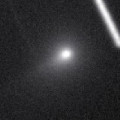
|
Bright new comet. Now it is so bright as 9.5 mag (Mar. 18, Sandor Szabo). In the Northern Hemisphere, it keeps locating extremely low and hard to observe. It will be getting higher gradually after May, but the comet will be fainter than 14 mag. It is not observable after this in the Southern Hemisphere.
Date(TT) R.A. (2000) Decl. Delta r Elong. m1 Best Time(A, h)
Apr. 11 1 23.35 31 39.3 1.858 1.023 23 11.6 19:56 (131, -1)
Apr. 18 1 27.72 36 59.8 1.920 1.118 26 12.3 3:56 (225, 2)
|
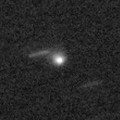
|
It will approach to the sun down to 0.3 a.u. in 2015 July, and it is expected to be bright. It brightened up to 15.6 mag in January (Jan. 13, Yasukazu Ikari). In the Southern Hemisphere, it is hard to observe for a while after this. But it will be observable after mid July, and keeps observable while the comet will be fading gradually. It will not be observable after this in the Northern Hemisphere.
Date(TT) R.A. (2000) Decl. Delta r Elong. m1 Best Time(A, h)
Apr. 11 0 34.92 -2 1.2 2.842 1.888 14 12.5 4:06 (261,-16)
Apr. 18 0 46.61 0 5.5 2.706 1.773 17 12.1 3:56 (260,-14)
|
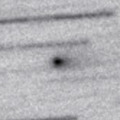
|
Now it is 15.5 mag (Mar. 1, Taras Prystavski). It is expected to brighten rapidly and will be observable in good condition at 13 mag from March to May.
Date(TT) R.A. (2000) Decl. Delta r Elong. m1 Best Time(A, h)
Apr. 11 18 43.15 -18 0.9 0.473 1.181 100 13.3 4:06 (337, 34)
Apr. 18 19 15.96 -16 40.7 0.468 1.173 99 13.2 3:56 (332, 33)
|
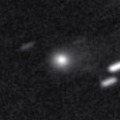
|
Now it is 14.9 mag (Apr. 1, Taras Prystavski). In 2015, it keeps 13-14 mag and will be observable in good condition for a long time.
Date(TT) R.A. (2000) Decl. Delta r Elong. m1 Best Time(A, h)
Apr. 11 19 7.74 -10 45.9 3.248 3.457 93 13.4 4:06 (326, 38)
Apr. 18 19 13.07 -10 21.1 3.158 3.458 98 13.4 3:56 (329, 39)
|

|
Now it is so faint as 16.8 mag (Mar. 16, Tsutomu Seki).
Date(TT) R.A. (2000) Decl. Delta r Elong. m1 Best Time(A, h)
Apr. 11 17 57.99 -31 24.0 5.625 6.053 110 13.6 4:06 (351, 23)
Apr. 18 17 58.00 -31 29.8 5.521 6.051 117 13.6 3:56 (355, 23)
|
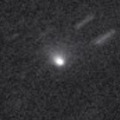
|
Now it is 15.2 mag and visible visually (Mar. 18, Sandor Szabo). It will brighten up to 11 mag in 2015 autumn. In this apparition, it is observable until the highlight while the comet is brightening.
Date(TT) R.A. (2000) Decl. Delta r Elong. m1 Best Time(A, h)
Apr. 11 12 46.44 3 21.4 1.425 2.410 166 14.1 23:28 ( 0, 58)
Apr. 18 12 40.10 4 5.3 1.404 2.368 158 13.9 22:54 ( 0, 59)
|

|
The spacecraft observed it brightened rapidly from 9 mag up to 2 mag when passing near by the sun. The nucleus has been already disintegrated, but the remnant was visible bright also on the earth (Mar. 7, Juan Jose Gonzalez). Now it is fainter than 10.3 mag (Mar. 17, Marek Biely). It locates high in the evening sky in the Northern Hemisphere. It is not observable in the Southern Hemisphere.
Date(TT) R.A. (2000) Decl. Delta r Elong. m1 Best Time(A, h)
Apr. 11 4 11.31 51 55.9 1.761 1.470 56 13.9 19:56 (133, 36)
Apr. 18 4 39.91 52 45.7 1.951 1.606 55 14.5 20:03 (134, 35)
|

|
It brightened up to 6.9 mag in 2014 autumn (Oct. 17, Marco Goiato). Now it is fading. But it is bright as 12.6 mag still now (Feb. 9, Chris Wyatt). In the Southern Hemisphere, it is unobservable temporarily now, but it will be observable in good condition again after mid April. It will be observable again in mid June also in the Northern Hemisphere.
Date(TT) R.A. (2000) Decl. Delta r Elong. m1 Best Time(A, h)
Apr. 11 0 41.46 -17 29.6 4.209 3.347 26 14.2 4:06 (274,-26)
Apr. 18 0 44.43 -17 9.1 4.243 3.424 31 14.3 3:56 (275,-23)
|
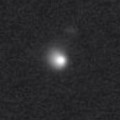
|
It brightened very rapidly. Now it is so bright as 14.6 mag and visible visually (Mar. 17, Sandor Szabo). It keeps 14-15 mag for a while after this. In the Northern Hemisphere, it will be getting lower gradually after May, and will be unobservable in mid June. In the Southern Hemisphere, it will be getting lower gradually after June, and will be unobservable in early August.
Date(TT) R.A. (2000) Decl. Delta r Elong. m1 Best Time(A, h)
Apr. 11 8 48.38 9 40.4 2.975 3.464 111 14.3 19:56 ( 14, 64)
Apr. 18 8 51.01 9 25.9 3.059 3.456 104 14.3 20:03 ( 30, 61)
|
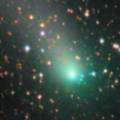
|
It brightened up to 9 mag from autumn to winter in 2014. Now it is fading rapidly. It has already faded down to 13.5 mag (Mar. 28, Taras Prystavski). In the Northern Hemisphere, it will be observable in excellent condition after this while the comet will be fading. In the Southern Hemisphere, it is hardly observable after this.
Date(TT) R.A. (2000) Decl. Delta r Elong. m1 Best Time(A, h)
Apr. 11 16 39.11 50 17.3 2.186 2.658 107 14.3 3:25 (180, 75)
Apr. 18 16 12.16 53 14.5 2.238 2.730 108 14.6 2:31 (180, 72)
|
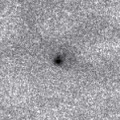
|
It must have brightened up to 11 mag from January to February, but no observations have been reported. Now it is 16.3 mag (Mar. 29, A. Maury, J.-F. Soulier, J.-G. Bosch, T. Noel). In the Southern Hemisphere, it is observable in the morning sky after this while the comet will be fading. It is hardly observable in the Northern Hemisphere.
Date(TT) R.A. (2000) Decl. Delta r Elong. m1 Best Time(A, h)
Apr. 11 23 20.84 -16 41.4 2.161 1.500 37 14.7 4:06 (284, -9)
Apr. 18 23 40.78 -15 41.0 2.176 1.546 39 14.8 3:56 (283, -9)
|

|
Now it is 13.5 mag (Mar. 14, Chris Wyatt). It is fainter than originally predicted by 2 mag. It will be fading gradually after this. But it keeps observable in good condition for a while.
Date(TT) R.A. (2000) Decl. Delta r Elong. m1 Best Time(A, h)
Apr. 11 11 13.60 19 26.3 1.672 2.517 139 14.9 21:56 ( 0, 74)
Apr. 18 11 12.34 18 45.8 1.760 2.552 132 15.1 21:27 ( 0, 74)
|

|
Very far object. However, outburst occured on Feb. 20, and now it brightened up to 15.3 mag (Feb. 28, Taras Prystavski). It is reported so bright visually as 12.5 mag (Mar. 22, Marco Goiato). It locates high in the Southern Hemisphere. But it locates somewhat low in the Northern Hemisphere.
Date(TT) R.A. (2000) Decl. Delta r Elong. m1 Best Time(A, h)
Apr. 11 12 7.45 -22 37.1 8.210 9.146 157 15.2 22:50 ( 0, 32)
Apr. 18 12 5.75 -22 17.8 8.231 9.145 154 15.2 22:21 ( 0, 33)
|

|
It brightened up to 10.6 mag from autumn to winter (Nov. 29, Seiichi Yoshida). Now it is 14.3 mag (Mar. 24, Taras Prystavski). It will be fading graudually after this. But it keeps observable for a long time until the comet fades out.
Date(TT) R.A. (2000) Decl. Delta r Elong. m1 Best Time(A, h)
Apr. 11 17 41.75 -14 36.1 1.789 2.388 114 15.2 4:06 (353, 40)
Apr. 18 17 40.76 -14 37.9 1.780 2.461 121 15.5 3:56 (359, 40)
|

|
It brightened up to 11-12 mag in 2012. It has already faded down to 15.2 mag (Mar. 16, Taras Prystavski). It keeps observable at 15 mag in good condition until summer.
Date(TT) R.A. (2000) Decl. Delta r Elong. m1 Best Time(A, h)
Apr. 11 11 14.78 -6 44.7 8.406 9.287 149 15.3 21:57 ( 0, 48)
Apr. 18 11 11.30 -6 20.0 8.507 9.324 142 15.3 21:26 ( 0, 49)
|

|
Now it is 15.3 mag (Jan. 7, Taras Prystavski). It keeps 15 mag for a long time from 2014 to 2015. It is observable in excellent condition in 2014 in the Southern Hemisphere, or in 2015 in the Northern Hemisphere. It becomes unobservable temporarily from March to May.
Date(TT) R.A. (2000) Decl. Delta r Elong. m1 Best Time(A, h)
Apr. 11 1 13.68 6 53.6 4.892 3.890 1 15.3 4:06 (247,-18)
Apr. 18 1 19.37 8 25.4 4.892 3.895 5 15.4 3:56 (248,-15)
|
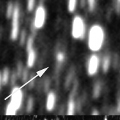
|
Now it is 15.3 mag (Mar. 28, Taras Prystavski). Distant object, but it keeps observable at 14-15 mag for a long time from 2015 to 2016.
Date(TT) R.A. (2000) Decl. Delta r Elong. m1 Best Time(A, h)
Apr. 11 21 8.35 -3 16.9 6.092 5.704 62 15.5 4:06 (293, 25)
Apr. 18 21 12.54 -2 53.6 5.973 5.679 68 15.4 3:56 (295, 27)
|
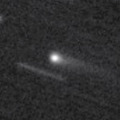
|
Now it is 15.7 mag (Mar. 31, MASTER-SAAO Observatory). It is expected to brighten up to 12 mag from July to August. In the Southern Hemisphere, it keeps observable in good condition until summer. In the Northern Hemisphere, it will be getting higher gradually after May, and will be observable in good condition after summer.
Date(TT) R.A. (2000) Decl. Delta r Elong. m1 Best Time(A, h)
Apr. 11 20 8.56 -42 32.7 2.130 2.288 85 15.7 4:06 (330, 4)
Apr. 18 20 19.14 -41 0.8 1.992 2.231 90 15.5 3:56 (331, 5)
|

|
First return of a comet re-discovered after 112-year blank in 2008. It brightened up to 12 mag in 2008. It is expected to brighten up to 15 mag from spring to summer in this apparition. It keeps locating low in the morning sky for a while.
Date(TT) R.A. (2000) Decl. Delta r Elong. m1 Best Time(A, h)
Apr. 11 22 31.00 -0 40.9 2.169 1.575 42 15.6 4:06 (278, 10)
Apr. 18 22 51.54 0 50.7 2.129 1.561 43 15.5 3:56 (276, 10)
|

|
Now it is 14.7 mag (Apr. 1, Taras Prystavski). It is observable at 15-16 mag in good condition in 2015.
Date(TT) R.A. (2000) Decl. Delta r Elong. m1 Best Time(A, h)
Apr. 11 18 58.61 -18 30.2 7.413 7.594 96 15.6 4:06 (332, 32)
Apr. 18 18 56.93 -18 49.3 7.319 7.623 103 15.6 3:56 (337, 33)
|
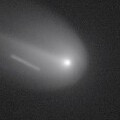
|
It brightened up to 7-8 mag in outburst twice from December to January. Now it is fading. It has already faded down to 13.4 mag (Mar. 16, Catalina Sky Survey). In the Northern Hemisphere, it will be getting lower gradually after this, and will be unobservable in late May. In the Southern Hemisphere, it keeps locating extremely low after this.
Date(TT) R.A. (2000) Decl. Delta r Elong. m1 Best Time(A, h)
Apr. 11 4 19.07 26 37.1 2.232 1.715 47 15.7 19:56 (104, 28)
Apr. 18 4 40.28 27 20.4 2.343 1.782 45 16.3 20:03 (107, 26)
|

|
Now it is 14.8 mag (Mar. 21, Taras Prystavski). In the Northern Hemisphere, it keeps 15-16 mag and observable in excellent condition until early summer. It locates somewhat low in the Southern Hemisphere.
Date(TT) R.A. (2000) Decl. Delta r Elong. m1 Best Time(A, h)
Apr. 11 13 1.82 33 26.9 3.062 3.868 138 15.8 23:44 ( 0, 88)
Apr. 18 12 56.69 32 40.6 3.116 3.895 135 15.9 23:11 ( 0, 88)
|

|
Now it is 14.8 mag and visible visually (Mar. 18, Sandor Szabo). It will pass close to the earth from spring to summer in 2016, and it is expected to be observable at 6-7 mag in good condition. It will be unobservable soon in the Southern Hemisphere. In the Northern Hemispehre, it will be getting lower gradually and will be unobservable temporarily in mid May.
Date(TT) R.A. (2000) Decl. Delta r Elong. m1 Best Time(A, h)
Apr. 11 4 45.71 33 34.6 5.274 4.762 54 15.9 19:56 (109, 36)
Apr. 18 4 47.02 33 28.3 5.307 4.696 48 15.8 20:03 (112, 29)
|
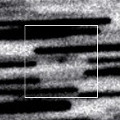
|
Now it is 16.6 mag (Apr. 1, Taras Prystavski). It is expected to brighten up to 15 mag in summer, and will be observable in excellent condition.
Date(TT) R.A. (2000) Decl. Delta r Elong. m1 Best Time(A, h)
Apr. 11 21 1.96 -14 9.2 1.907 1.770 66 16.1 4:06 (303, 18)
Apr. 18 21 19.55 -12 46.8 1.843 1.758 69 15.9 3:56 (302, 19)
|

|
It brightened rapidly. Now it is 16.0 mag, much brighter than origianlly predicted (Mar. 28, Taras Prystavski). However, it will fade out rapidly after this.
Date(TT) R.A. (2000) Decl. Delta r Elong. m1 Best Time(A, h)
Apr. 11 16 23.21 -29 25.5 0.894 1.727 131 16.1 3:09 ( 0, 26)
Apr. 18 16 24.86 -31 1.1 0.889 1.763 137 16.3 2:43 ( 0, 24)
|

|
Now it is 17.6 mag (Feb. 23, Mitsunori Tsumura). It will brighten up to 13 mag in 2016. It will be getting lower after this, and will be unobservable in early June. It is fainter than this ephemeris recently.
Date(TT) R.A. (2000) Decl. Delta r Elong. m1 Best Time(A, h)
Apr. 11 6 14.76 26 50.6 2.974 2.842 72 16.2 19:56 ( 90, 51)
Apr. 18 6 23.24 26 40.4 3.038 2.817 67 16.1 20:03 ( 94, 46)
|

|
Now it is 16.1 mag (Mar. 31, Polonia Observatory). It approaches to the earth, and brightens up to 16 mag from April to May. But it will be fainter than 18 mag in July. It is observable in excellent condition in the Southern Hemisphere. It will be observable in excellent condition after May also in the Northern Hemisphere.
Date(TT) R.A. (2000) Decl. Delta r Elong. m1 Best Time(A, h)
Apr. 11 20 4.00 -39 54.1 0.786 1.231 86 16.4 4:06 (330, 6)
Apr. 18 20 31.08 -33 47.4 0.755 1.212 85 16.2 3:56 (325, 10)
|
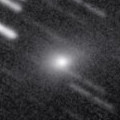
|
It brightened up to 13.8 mag in winter (Feb. 15, Jakub Cerny). Now it is fading. It has already faded down to 15.2 mag (Mar. 17, Space Surveillance Telescope, Atom Site). It will be getting lower after May. It will be unobservable in June in the Northern Hemisphere, or in July in the Southern Hemisphere.
Date(TT) R.A. (2000) Decl. Delta r Elong. m1 Best Time(A, h)
Apr. 11 7 1.16 18 32.0 2.475 2.571 83 16.5 19:56 ( 69, 57)
Apr. 18 7 10.17 18 4.3 2.573 2.582 79 16.7 20:03 ( 74, 51)
|
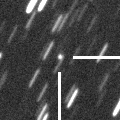
|
Brightened rapidly, and it keeps brightening even after the perihelion passage. Now it is bright as 15.8 mag and visible visually (Mar. 18, Sandor Szabo). It seems to keep 16 mag for some more time. It is observable in excellent condition in the Northern Hemisphere. It is not observable in the Southern Hemisphere.
Date(TT) R.A. (2000) Decl. Delta r Elong. m1 Best Time(A, h)
Apr. 11 7 37.14 50 35.1 1.858 2.066 87 16.6 19:56 (139, 67)
Apr. 18 7 56.28 49 14.8 1.947 2.101 84 16.7 20:03 (133, 65)
|
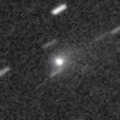
|
Now it is 15.2 mag and visible visually (Mar. 18, Sandor Szabo). It keeps observable in good condition after this, but it will be fading gradually.
Date(TT) R.A. (2000) Decl. Delta r Elong. m1 Best Time(A, h)
Apr. 11 11 50.54 11 37.5 1.495 2.421 151 16.6 22:33 ( 0, 67)
Apr. 18 11 48.10 11 41.4 1.565 2.449 144 16.8 22:03 ( 0, 67)
|
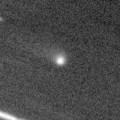
|
Now it is 15.3 mag (Mar. 16, Taras Prystavski). It keeps 17-18 mag for a long time from 2014 to 2016.
Date(TT) R.A. (2000) Decl. Delta r Elong. m1 Best Time(A, h)
Apr. 11 11 31.06 -21 16.9 4.475 5.376 151 16.8 22:13 ( 0, 34)
Apr. 18 11 22.04 -20 30.6 4.530 5.382 144 16.8 21:36 ( 0, 34)
|

|
Now it is 17.7 mag (Feb. 17, K. Hills). It keeps observable at 17 mag from spring to summer. It locates somewhat low in the Northern Hemisphere.
Date(TT) R.A. (2000) Decl. Delta r Elong. m1 Best Time(A, h)
Apr. 11 17 19.24 -29 2.5 2.534 3.149 119 17.0 4:05 ( 0, 26)
Apr. 18 17 20.16 -28 57.5 2.456 3.152 125 16.9 3:38 ( 0, 26)
|
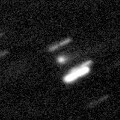
|
Now it is 15.9 mag (Mar. 11, Taras Prystavski). It keeps observable at 16-17 mag in good condition for a while.
Date(TT) R.A. (2000) Decl. Delta r Elong. m1 Best Time(A, h)
Apr. 11 7 59.09 14 8.6 3.898 4.163 98 16.9 19:56 ( 43, 63)
Apr. 18 8 2.49 14 5.4 4.008 4.171 92 17.0 20:03 ( 55, 58)
|
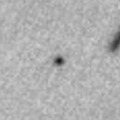
|
Now it is 17.8 mag (Feb. 25, A. Diepvens). It keeps observable after this while the comet will be getting brighter graudually. It will brighten up to 11 mag from autumn to winter. But it locates low at that time.
Date(TT) R.A. (2000) Decl. Delta r Elong. m1 Best Time(A, h)
Apr. 11 14 48.78 4 21.9 1.524 2.463 153 17.1 1:35 ( 0, 59)
Apr. 18 14 43.59 5 18.2 1.460 2.420 157 16.9 1:02 ( 0, 60)
|
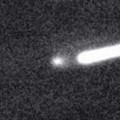
|
It brightened up to 15.5 mag from autumn to winter (Nov. 25, Taras Prystavski). Now it is fading. It has already faded down to 16.7 mag (Mar. 28, Taras Prystavski). It keeps observable in good condition for a while.
Date(TT) R.A. (2000) Decl. Delta r Elong. m1 Best Time(A, h)
Apr. 11 17 56.09 -9 13.6 1.757 2.312 110 17.2 4:06 (348, 45)
Apr. 18 17 58.37 -8 53.7 1.721 2.352 116 17.3 3:56 (353, 46)
|
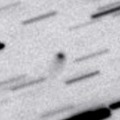
|
Now it is 18.0 mag (Feb. 27, W. Hasubick). It keeps observable at 17-18 mag for a long time from 2013 to 2016. It keeps locating high in the Northern Hemisphere. It keeps locating very low in the Southern Hemipshere.
Date(TT) R.A. (2000) Decl. Delta r Elong. m1 Best Time(A, h)
Apr. 11 16 56.50 61 41.4 6.435 6.655 98 17.3 3:42 (180, 63)
Apr. 18 16 46.51 62 49.7 6.443 6.666 98 17.3 3:04 (180, 62)
|
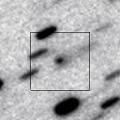
|
Now it is 17.2 mag (Mar. 24, iTelescope Observatory, Siding Spring). It keeps 17 mag until July. It is observable in excellent condition in the Southern Hemisphere. It locates somewhat low in the Northern Hemisphere.
Date(TT) R.A. (2000) Decl. Delta r Elong. m1 Best Time(A, h)
Apr. 11 16 46.60 -23 22.1 1.811 2.547 127 17.3 3:32 ( 0, 32)
Apr. 18 16 47.03 -23 33.1 1.746 2.549 134 17.3 3:05 ( 0, 31)
|

|
Now it is 17.7 mag (Jan. 20, Taras Prystavski). It was observed at 17 mag in 2014 summer. In the Northern Hemisphere, it is observable at 17.5 mag in excellent condition also in 2015. It is not observable in the Southern Hemisphere.
Date(TT) R.A. (2000) Decl. Delta r Elong. m1 Best Time(A, h)
Apr. 11 21 21.35 42 29.0 4.438 4.060 61 17.3 4:06 (242, 44)
Apr. 18 21 30.17 43 37.0 4.431 4.079 63 17.3 3:56 (241, 45)
|
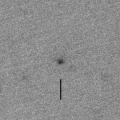
|
Now it is 18.6 mag (Feb. 16, K. Hills). It will brighten up to 14 mag and will be observable in good condition in 2016.
Date(TT) R.A. (2000) Decl. Delta r Elong. m1 Best Time(A, h)
Apr. 11 12 47.42 1 41.6 2.778 3.764 167 17.4 23:29 ( 0, 57)
Apr. 18 12 43.20 2 13.2 2.768 3.730 160 17.4 22:58 ( 0, 57)
|

|
Now it is 19.3 mag (Mar. 27, Pan-STARRS 1, Haleakala). It will brighten rapidly, and will be observable at 16.5 mag in good condition from May to July.
Date(TT) R.A. (2000) Decl. Delta r Elong. m1 Best Time(A, h)
Apr. 11 16 23.24 -23 4.6 1.115 1.940 132 17.6 3:09 ( 0, 32)
Apr. 18 16 27.77 -22 13.4 1.042 1.915 138 17.4 2:46 ( 0, 33)
|
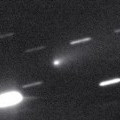
|
Now it is 16.0 mag (Mar. 20, Yasukazu Ikari). It keeps observable for a long time after this while the comet will be fading gradually.
Date(TT) R.A. (2000) Decl. Delta r Elong. m1 Best Time(A, h)
Apr. 11 9 8.83 8 6.9 2.610 3.183 116 17.4 19:56 ( 2, 63)
Apr. 18 9 10.98 8 23.6 2.739 3.223 109 17.6 20:03 ( 20, 62)
|

|
It has not been observed yet in this apparition. But it must have already brightened up to 17.5 mag. It will be observable at 13 mag in good condition from summer to autumn.
Date(TT) R.A. (2000) Decl. Delta r Elong. m1 Best Time(A, h)
Apr. 11 21 27.55 -17 28.4 2.330 2.057 61 17.7 4:06 (301, 12)
Apr. 18 21 43.45 -16 27.2 2.234 2.023 64 17.4 3:56 (300, 12)
|

|
First return of a periodic comet discovered in 1994. Now it is 18.0 mag (Mar. 31, MASTER-SAAO Observatory). It will brighten up to 15 mag from summer to autumn, and will be observable in excellent condition in the Southern Hemisphere. It locates somewhat low in the Northern Hemisphere.
Date(TT) R.A. (2000) Decl. Delta r Elong. m1 Best Time(A, h)
Apr. 11 21 15.58 -33 3.7 3.170 2.985 70 17.6 4:06 (314, 3)
Apr. 18 21 27.04 -32 49.0 3.056 2.952 74 17.5 3:56 (315, 4)
|

|
It brightened up to 6.5 mag in September (Sept. 21, Marco Goiato). Now it is fading rapidly. It has already faded down to 16.9 mag (Mar. 28, Taras Prystavski).
Date(TT) R.A. (2000) Decl. Delta r Elong. m1 Best Time(A, h)
Apr. 11 13 55.33 26 15.5 2.317 3.185 144 17.6 0:42 ( 0, 81)
Apr. 18 13 38.98 27 19.9 2.419 3.270 142 17.8 23:52 ( 0, 82)
|
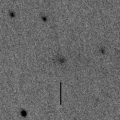
|
It will brighten up to 14 mag in 2016 spring. Now it is 16.5 mag (Mar. 30, Taras Prystavski). In 2015, it is observable in good condition until spring in the Northern Hemisphere. In the Southern Hemisphere, it is not observable in 2015. But it will be observable in good condition at the high light in 2016.
Date(TT) R.A. (2000) Decl. Delta r Elong. m1 Best Time(A, h)
Apr. 11 7 22.83 37 3.9 3.715 3.788 86 17.6 19:56 (103, 68)
Apr. 18 7 27.21 36 28.0 3.759 3.733 80 17.6 20:03 (103, 62)
|

|
Now it is 17.5 mag (Feb. 19, W. Hasubick). It was observed around 17-18 mag in early 2014. It will be observable around 17-18 mag again from 2014 autumn to 2015 spring, in excellent condition in the Northern Hemisphere. It is not observable in the Southern Hemisphere.
Date(TT) R.A. (2000) Decl. Delta r Elong. m1 Best Time(A, h)
Apr. 11 9 51.82 51 26.8 4.903 5.271 106 17.7 20:35 (180, 74)
Apr. 18 9 51.07 50 18.1 4.996 5.283 101 17.7 20:07 (180, 75)
|
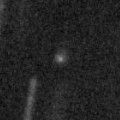
|
Now it is 17.7 mag (Feb. 24, K. Hills). It keeps observable at 17 mag from winter to spring. It is observable in excellent condition in the Southern Hemisphere. But it locates somewhat low in the Northern Hemisphere.
Date(TT) R.A. (2000) Decl. Delta r Elong. m1 Best Time(A, h)
Apr. 11 10 19.01 -31 35.0 2.328 3.096 132 17.7 21:01 ( 0, 23)
Apr. 18 10 12.79 -31 52.7 2.387 3.101 127 17.8 20:28 ( 0, 23)
|
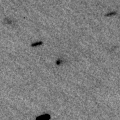
|
Now it is 17.6 mag (Jan. 21, Catalina Sky Survey). Now it is around the aphelion. In the Northern Hemisphere, it is observable at 18 mag in good condition from winter to spring. It locates somewhat low in the Southern Hemisphere.
Date(TT) R.A. (2000) Decl. Delta r Elong. m1 Best Time(A, h)
Apr. 11 8 30.09 28 40.8 4.199 4.515 102 17.8 19:56 ( 58, 79)
Apr. 18 8 31.44 28 24.0 4.294 4.505 95 17.8 20:03 ( 73, 72)
|

|
Now it is 16.6 mag (Feb. 20, Yasukazu Ikari). It keeps 18 mag from 2014 to 2015. In 2015, it keeps observable in good condition from winter to spring.
Date(TT) R.A. (2000) Decl. Delta r Elong. m1 Best Time(A, h)
Apr. 11 10 27.00 -10 50.1 5.279 6.064 138 17.9 21:10 ( 0, 44)
Apr. 18 10 25.63 -10 46.4 5.361 6.077 131 18.0 20:41 ( 0, 44)
|
|
![]()
 C/2015 F5 ( SWAN-Xingming )
C/2015 F5 ( SWAN-Xingming ) C/2015 F3 ( SWAN )
C/2015 F3 ( SWAN ) 19P/Borrelly
19P/Borrelly 6P/d'Arrest
6P/d'Arrest C/2013 US10 ( Catalina )
C/2013 US10 ( Catalina ) C/2015 C2 ( SWAN )
C/2015 C2 ( SWAN ) C/2014 Q1 ( PanSTARRS )
C/2014 Q1 ( PanSTARRS ) 218P/LINEAR
218P/LINEAR C/2012 F3 ( PanSTARRS )
C/2012 F3 ( PanSTARRS ) 29P/Schwassmann-Wachmann 1
29P/Schwassmann-Wachmann 1 22P/Kopff
22P/Kopff C/2015 D1 ( SOHO )
C/2015 D1 ( SOHO ) C/2012 K1 ( PanSTARRS )
C/2012 K1 ( PanSTARRS ) C/2014 W11 ( PanSTARRS )
C/2014 W11 ( PanSTARRS ) C/2013 A1 ( Siding Spring )
C/2013 A1 ( Siding Spring ) 7P/Pons-Winnecke
7P/Pons-Winnecke 32P/Comas Sola
32P/Comas Sola C/2013 C2 ( Tenagra )
C/2013 C2 ( Tenagra ) C/2014 R1 ( Borisov )
C/2014 R1 ( Borisov ) C/2006 S3 ( LONEOS )
C/2006 S3 ( LONEOS ) C/2014 N3 ( NEOWISE )
C/2014 N3 ( NEOWISE ) C/2011 KP36 ( Spacewatch )
C/2011 KP36 ( Spacewatch ) C/2015 F4 ( Jacques )
C/2015 F4 ( Jacques ) 205P/Giacobini
205P/Giacobini C/2010 S1 ( LINEAR )
C/2010 S1 ( LINEAR ) 15P/Finlay
15P/Finlay C/2013 V2 ( Borisov )
C/2013 V2 ( Borisov ) C/2013 X1 ( PanSTARRS )
C/2013 X1 ( PanSTARRS ) 57P/du Toit-Neujmin-Delporte
57P/du Toit-Neujmin-Delporte C/2014 W9 ( PanSTARRS )
C/2014 W9 ( PanSTARRS ) 116P/Wild 4
116P/Wild 4 C/2015 F2 ( Polonia )
C/2015 F2 ( Polonia ) 110P/Hartley 3
110P/Hartley 3 P/2014 X1 ( Elenin )
P/2014 X1 ( Elenin ) 70P/Kojima
70P/Kojima C/2013 G9 ( Tenagra )
C/2013 G9 ( Tenagra ) 299P/2014 D2 ( Catalina-PanSTARRS )
299P/2014 D2 ( Catalina-PanSTARRS ) 269P/2012 R2 ( Jedicke )
269P/2012 R2 ( Jedicke ) 10P/Tempel 2
10P/Tempel 2 40P/Vaisala 1
40P/Vaisala 1 C/2012 K8 ( Lemmon )
C/2012 K8 ( Lemmon ) P/2015 F1 ( PanSTARRS )
P/2015 F1 ( PanSTARRS ) C/2013 G3 ( PanSTARRS )
C/2013 G3 ( PanSTARRS ) 53P/Van Biesbroeck
53P/Van Biesbroeck 221P/LINEAR
221P/LINEAR 4P/Faye
4P/Faye 51P/Harrington
51P/Harrington 318P/2014 M6 ( McNaught-Hartley )
318P/2014 M6 ( McNaught-Hartley ) C/2013 V5 ( Oukaimeden )
C/2013 V5 ( Oukaimeden ) C/2014 Y1 ( PanSTARRS )
C/2014 Y1 ( PanSTARRS ) C/2013 U2 ( Holvorcem )
C/2013 U2 ( Holvorcem ) C/2014 W6 ( Catalina )
C/2014 W6 ( Catalina ) 65P/Gunn
65P/Gunn C/2013 TW5 ( Spacewatch )
C/2013 TW5 ( Spacewatch )![]()

















































